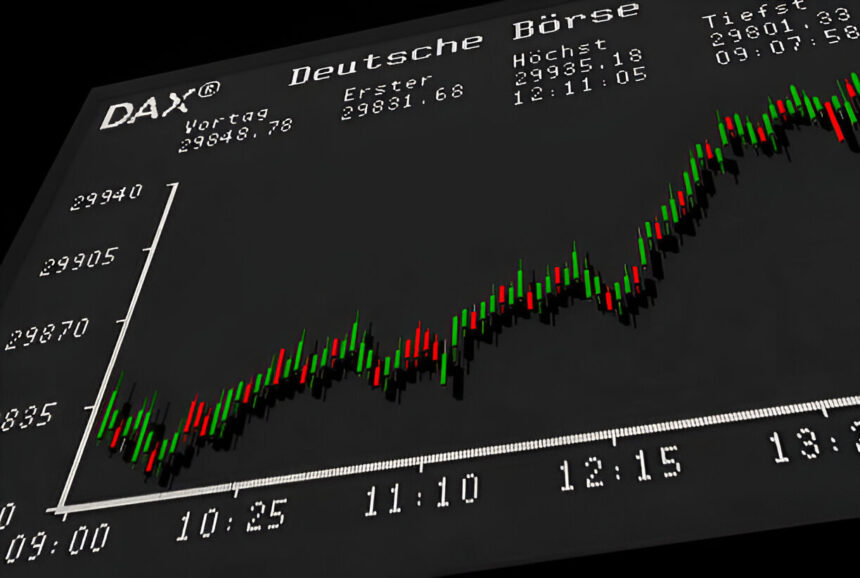The European equities, particularly the bellwether German DAX index, experienced a volatile session on July 31, 2025, initially showing promise but ultimately failing to hold onto early gains. This intraday reversal is a symptom of deeper anxieties simmering beneath the surface of what appears to be a global economic rebound. As a seasoned observer of these markets for decades, I can tell you these moments of indecision often signal a re-evaluation of fundamental assumptions, influenced by a confusing combination of economic data, central bank rhetoric, and lingering global uncertainties.
What Caused the DAX to Fail to Hold Its Gains?
The DAX’s failure to hold onto early gains on Thursday, July 31, 2025, can be attributed to a confluence of factors that created a whipsaw effect in market sentiment. The index opened strongly at 24340.21 and ascended to an intraday high of 24433.4, driven by initial optimism. This optimism was primarily fueled by stronger-than-expected U.S. Q2 GDP growth, which came in at an annualized rate of 3.0%. This headline figure suggested a robust rebound from the prior quarter’s contraction and gave global markets a positive initial push.
However, the enthusiasm quickly waned as investors examined the details. The U.S. GDP report, while strong on the surface, revealed underlying weaknesses: a significant portion of the growth was attributed to a sharp decrease in imports (a subtraction in GDP calculation), rather than robust organic domestic demand. Private investment also plunged, and consumer spending, though improved, remained lackluster. This suggested that the headline growth was heavily influenced by trade policy distortions rather than sustainable economic strength. This subtle but crucial distinction likely prompted a reassessment of risk, causing the DAX to shed its earlier advances and slide towards the close, ultimately settling at 24065.47, a decline of 0.81% for the day.
How Do European Inflation and Business Sentiment Influence the DAX?
European economic data is important because it influences investor confidence and, consequently, the performance of indices like the DAX. Recent inflation figures and business sentiment surveys provide a mixed picture that contributed to the DAX’s struggle.
Preliminary Eurozone inflation for July hit an anticipated 1.9% year-over-year. This is below June’s 2.0% and the ECB’s 2% target. Core inflation also softened, expected at 2.2%. This disinflationary trend might pave the way for later ECB rate cuts, typically supporting equities by lowering borrowing costs.
Despite positive inflation data, German business sentiment remained cautious. The Ifo Business Climate Index rose slightly to 88.6 in July (from 88.4 in June) but missed market expectations of 89.0. This shows companies are slightly more satisfied now, yet their six-month outlook is largely unchanged. Persistent weak external demand, geopolitical trade tensions, and muted domestic consumption still weigh on the economy. This divergence—cooling inflation versus underlying business caution—means positive news can quickly be overshadowed by lingering concerns.
From my years navigating global financial markets, I’ve observed a paradox: a central bank’s “wait-and-see” approach, even amid disinflation, can dampen equity enthusiasm. Traders and investors often see a lack of immediate, aggressive rate action as a sign that wider economic worries outweigh the need for significant stimulus. This can foster a ‘risk-off’ sentiment, overriding initial positive data and causing indices like the DAX to falter.
What Role Does the ECB Play in the DAX’s Movements?
The European Central Bank (ECB) heavily influences Eurozone market sentiment, including the DAX, through its monetary policy decisions.
The ECB held interest rates steady at its July 24th meeting, with the deposit facility rate at 2.00%. This signals a period of assessment. While inflation nears their 2% target, the Governing Council remains wary of the “exceptionally uncertain” global environment, especially due to trade disputes. This prudent stance means the ECB isn’t rushing into further easing. Such caution creates a ceiling for immediate market exuberance. Investors understand significant stimulus is unlikely until the economic picture clarifies. The market now anticipates potential rate cuts in September or later, depending on future data.
Intraday Dynamics and Key DAX Constituents on July 31st
A closer look at the DAX’s intraday trading on July 31st reveals the nuances of its reversal. The index climbed to its high early in the session, testing crucial resistance levels. For instance, the DAX notably encountered resistance around the 24,499.8 and 24,332.48 levels, failing to sustain momentum above these points despite the positive opening. Its eventual fall saw it breach intraday support at 24,218.8 and test lower levels around 24,070.78 before finding some footing just above its intraday low of 24,039.92. This technical failure to hold above established resistance, combined with declining enthusiasm, precipitated the downturn.
The performance of individual DAX constituents underscored the mixed sentiment:
Gainers: Some companies managed to buck the trend. Heidelberg Materials (+1.76%), Symrise AG (+1.71%), and Commerzbank (+1.17%) were among the notable outperformers, perhaps reflecting idiosyncratic positive news or sector-specific resilience.
Losers: Conversely, major players dragged the index down. Siemens Healthineers (-4.43%), Zalando SE (-4.21%), and Adidas (-3.92%) experienced significant declines. Beyond macro trends, specific corporate earnings, sector challenges (e.g., consumer discretionary or healthcare), and company guidance profoundly influenced daily stock movements. This divergence highlights a discerning market, where broad positive sentiment is insufficient to lift all boats.
Navigating the Current Market Environment: A Seasoned Perspective
The DAX’s recent performance is a classic example of markets trying to reconcile conflicting signals. On one hand, there’s a narrative of global economic resilience, supported by headline U.S. GDP and cooling inflation in Europe. On the other, the granular details reveal vulnerabilities: trade policy distortions, subdued business confidence, and central banks maintaining a watchful stance.
A key tell in market reversals, from my decades of observation, is failing to break significant technical resistance on volume. On July 31st, the DAX’s inability to clear the 24,400-24,500 zone, coupled with component selling, signaled weak buying conviction against macro anxieties. This is a recurring pattern: headline optimism often collapses after sober detail review and technical rejections.
Looking ahead, this recent volatility aligns with expert short-term views. Despite the DAX’s strong uptrend, some analysts suggest short-term profit-taking and corrections are overdue. For the remainder of 2025, experts forecast the DAX could reach 30,000 by year-end if it holds above 20,000. Longer-term, bullish projections see 40,000 by 2030, though downturns remain inevitable. Further ECB rate cuts and increased Eurozone defense spending could drive continued upside, benefiting sectors like industrials and technology.
For traders, this environment demands agility. Intraday swings are likely to remain pronounced as markets digest new information. Focusing on strong technical levels, coupled with a deep understanding of the fundamental drivers, becomes paramount. Range-bound trading strategies might prove more effective than chasing breakouts that could quickly reverse, especially when previous highs act as strong resistance points.</p>
For long-term investors, the situation reinforces the importance of sector-specific analysis and diversification. While the overall index might be stagnant, certain sectors or individual companies less exposed to trade risks or with strong domestic demand could outperform. This is a time for patience and selective positioning, rather than broad-brush enthusiasm. The market is subtly telling us that while the immediate storm might be passing, the economic seas are far from calm. The real opportunities, and risks, lie in understanding these undercurrents.
Conclusion: A Cautious Equilibrium
The DAX struggled on July 31st, reflecting a market torn between economic resilience and lingering global uncertainties. The ECB’s caution, mixed business sentiment, and sector divergence reinforce a careful equilibrium, not exuberant growth. The intraday technical rejection at key resistance levels further underscores the underlying hesitancy among market participants. For market participants, this period demands a nuanced approach. It prioritizes meticulous analysis of economic indicators and recognizes the lasting impact of geopolitical shifts. The DAX and European equities’ path forward hinges on resolving these fundamental tensions, not daily fluctuations.
What specific economic indicators or geopolitical developments are you most closely watching to gauge the DAX’s next significant move? Share your insights in the comments below.









